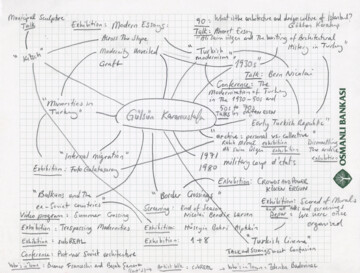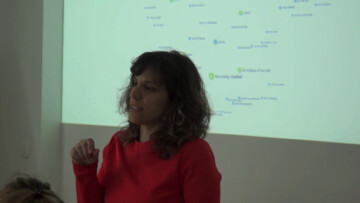SALT suggested the term “intuition”, with the aim of revealing the interrelations among research and programs that are unlikely to appear without specific inspections. Considering historicisation as an intentional act, the term “intuition” was selected to demonstrate a distinction between what can be considered the most common cultural method of historicisation, the act of archiving, and a more fluid approach that builds new conduits of research and knowledge through non-systematic accumulation. SALT’s toying with the term intuition is an attempt to define the grey areas in the ways cultural institutions function in reality, and it also speaks of the aspiration to individualise the very idea of the form of the institution.
SALT proves to be resourceful in such an inquiry, primarily due to its non-hierarchical and non-departmental structure. This can be observed in a SALT map generated by the workshops titled In Situ Qualitative, that describes decentralised work patterns and the attitude of collaborating with external individuals rather than creating a workforce that aims to grapple with numerous types of expertise. Such a setting allows for informal and multidirectional exchanges in the development of “programs and research”, the main office where the SALT team organises their thinking to incorporate contemporary art, architecture and social historical → archives, that eventually lead to related exhibitions and public programs. In the workshops, SALT’s programmers took the institution’s long-term programs as case studies to define qualities that appeared to influence their cultural practice. Different aims and outcomes, including intuition, were specified and voted upon for each program. Surprisingly, exhibitions tagged with the quality intuition do not share obvious characteristics, such as belonging to the same discipline, era, medium, or geographic area, nor were they treated similarly in development. Their particular intuitiveness lies within the context that conceived them and the interactions among the programmers, researchers and artists who originally initiated them. These interactions refer to conversations and discussions unearthing various urgencies, and exploring them with multiple inputs.
The examples include the mid-career exhibition of Hassan Khan, an artist who had yet to present a major exhibition of his work in the region within which his practice was developed, and these two programs, the most conventional examples for an institutional setting, being contemporary art exhibitions, were formed in response to current debates and a feeling of timely urgency. Dramatically different, yet of the same medium, the exhibitions IStory by Hrair Sarkissian and One, No one and One Hundred Thousand by Elio Montanari, presented two artists who share very individual approaches to personally constructed, rather than historically embedded, activities of archiving. Stemming from a shared → interest in a design of material experiences and their immaterial experiments in the recent past, the exhibitions Salon and Global Tools formalised research in utterly distinct ways. The former performed the paper document by (re)placing a set of period furniture in a selectively reproduced domestic setting, whereas the latter initiated a live discussion out of the documentation of a 1970s experimentation from a non-school of design.

Duygu Demir & Merve Elveren, Gülsün Karamustafa, work on paper, A3, 2013. Chart of SALT-based influence in making the exhibition A Promised Exhibition of Gülsün Karamustafa. Courtesy of Duygu Demir and Merve Elveren.
Such seemingly disparate yet related → interventions define the institution’s practice, since it builds an invisible circuit in the background without being overly concerned about servicing the available and complete. It leads to a commonality of individual interests, for example when Simone Forti and Jeremiah Day’s performance Body Mind World, without explicit pre-motivation from the programs team, met the works of the Body Seminar Group of Global Tools in the same time frame. The act of an institutional subliminal consciousness is straight and obvious in the sources-map that explains how SALT’s two and a half year programming fed into Gülsün Karamustafa’s exhibition. The underlying topics of A Promised Exhibition were visited in diversity, by contributors from a range of backgrounds at SALT. The sources map voids the idea of “intuition”, by qualifying a number of former programs as pre-emptive and post-intuitive of the final presentation. An exhibition that potentially offered full-circle closure on some of the debates held earlier within the institution.
The cultural institution has long been a powerful tool for recording and resurfacing memory, and it is challenged to become more so within contemporary environments charged with socio-political conflicts and locally the sufferance of acute amnesia in Turkey. These environments are inherently full of states of urgency. One fine mark of the intuitive is its openness to an agile attitude that can speak to the world on an immediate and daily time frame. SALT’s experience with agility was demonstrated in the 2014 program One Work, a serial exhibition of borrowed works from the L’Internationale member collections. Running continuously throughout the year in different corners of the three venues of SALT, the program mirrored the dynamic and political tension on the streets of Istanbul in the form of internationally acclaimed artworks.
Paralleling its → historicising role, the institution builds a → self-reflexive history as it continues to produce narratives and define itself as having a socially engaged position through them. Following a tangible external rhythm, SALT does this through the rapid sharing and free flow of information and knowledge. Under such circumstances, acknowledging intuition as a key device is an invitation to read the institution as a free-flowing web of materials in action, as opposed to a linear and mechanical understanding of it.



